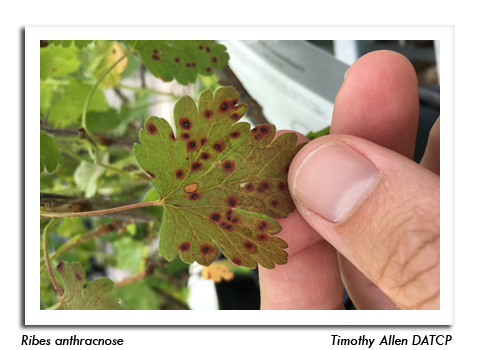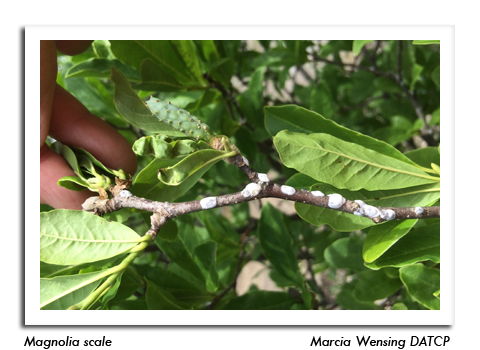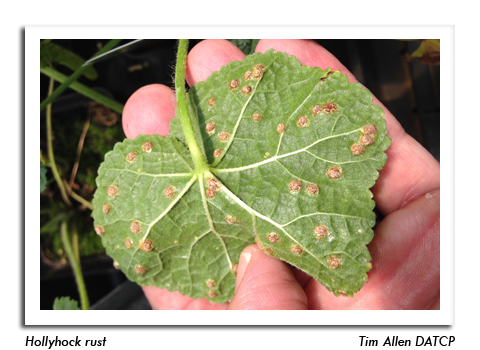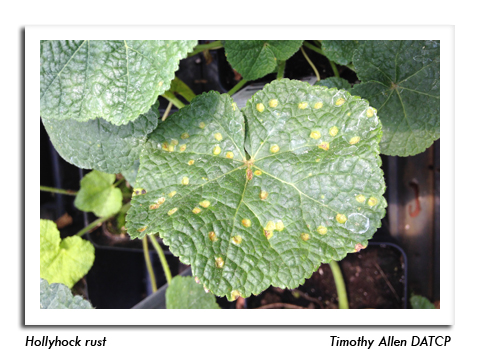
 |
|
|
Nursery & Forest
Volume 63 Number 9 Date 06/28/2018 GOOSEBERRY ANTHRACNOSE - Gooseberry plants with significant spotting attributed to Ribes anthracnose were found in Marathon County last week. This disease, caused by the fungus Drepanopeziza ribis, progresses quickly when leaves remain damp and can lead to significant premature leaf drop, as well as reduced vigor and productivity. Symptoms include small, dark-brown, round or irregular leaf spots with grayish bodies (acervuli) developing into leaf lesions with purple margins and tan centers. Adequate plant spacing allowing for good air circulation is important when considering location and density of stock. Removing fallen leaves and cultivating the area around the plant helps reduce the occurrence of infections by limiting the amount of inoculum available to infect plants the following spring. -- Timothy Allen, DATCP Nursery Inspector WHITE PINE BLISTER RUST - Homeowners and landscapers are reminded that species in the Ribes genus (currant and gooseberry) are alternate hosts for the white pine blister rust fungus. Planting currants and gooseberries near white pines should be avoided. White pine blister rust damages trees by causing branch cankers, ultimately killing trees by preventing nutrient flow. MAGNOLIA SCALE - Nymphs are maturing, and their white mealy wax is appearing on the branches of infested magnolias in southeastern Wisconsin. As the wax fades in August, the elliptical, shiny brown adult females will become noticeable. Nursery managers and residents are advised to inspect magnolias now and plan to spray heavily-infested trees in late August or early September, following with a second treatment 10 to 14 days later. Proper timing of the application is critical as only the young crawlers are easily controlled. Products containing bifenthrin, carbaryl, cyflulthrin, horticultural oil, insecticidal soap, malathion, or permethrin are appropriate for use in late summer. POWDERY MILDEW - Rose and Black-eyed Susan plants in Milwaukee County were infected with this common fungal disease. Powdery mildew is easily diagnosed on most plants, characterized by a grayish white powdery dusting on the upper leaves, which causes foliage to turn yellow and senesce prematurely. Widespread powdery mildew infestation can be difficult to manage. Cultural practices that increase air circulation help reduce mildew development, and applications of copper-based fungicides remain the only practical chemical control option. ROSE CHAFER - Beetles are a common problem in nurseries, with light to moderate leaf skeletonization and damage to the shoot tips of trees observed by inspectors. Chafer populations are especially high in areas of the state with sandy soils. The adult beetles are only active for about 3-4 weeks in June and should soon disappear for the season. HOLLYHOCK RUST - Nursery inspectors report that this disease is evident on hollyhock plants throughout the state. Symptoms include conspicuous yellow pinspots on the upper surface of leaves that correspond with orange-brown rust pustules on leaf undersides. Rust symptoms spread rapidly under favorably wet conditions and increase in severity as the season progresses, killing most foliage on infected plants by late summer. In severe cases, the fungus enters the stem and kills the plant. The flowers are generally not affected. Control involves removing symptomatic leaves in spring as soon as they are observed. Older infected plants should be cut down and burned once flowering is complete. Round-leaf mallow, a common weed, can harbor the fungus, so thorough weeding may be helpful. Fungicides are also available for control. -- Timothy Allen, Konnie Jerabek & Tim Boyle, DATCP Nursery Inspectors 





|
|
|